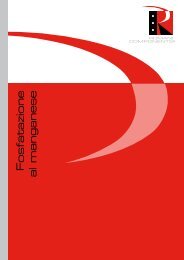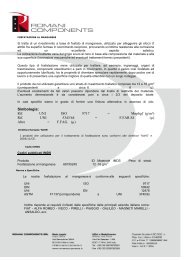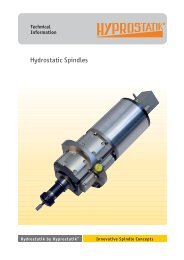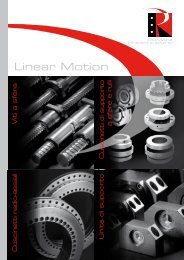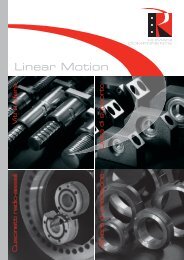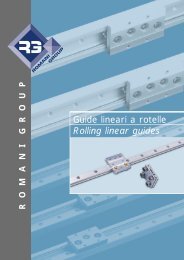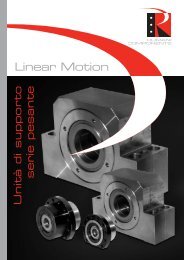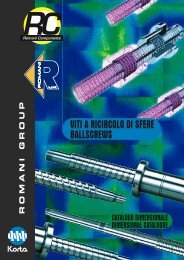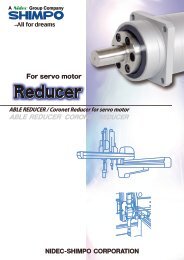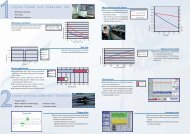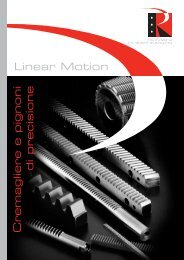catalogo tecnico technical catalogue - Romani Components
catalogo tecnico technical catalogue - Romani Components
catalogo tecnico technical catalogue - Romani Components
Create successful ePaper yourself
Turn your PDF publications into a flip-book with our unique Google optimized e-Paper software.
3<br />
Rigidez axial en la zona de contacto de las bolas (Rb/t)<br />
Axial Stiffness in the Contact Area of Balls (Rb/t)<br />
Como se puede apreciar en la figura 46, al<br />
aplicar una carga axial F e , esta origina una<br />
deformación elástica ∆l b/t en la zona de contacto<br />
de las bolas con el husillo y con la tuerca. Por<br />
lo tanto, la rigidez en la zona de contacto será<br />
aproximadamente:<br />
As can be seen in figure 46, the application<br />
of an axial load F e leads to some elastic deformation<br />
∆l b/t in the area of contact between the<br />
balls and the ball screw shaft and between the<br />
balls and the nut. Thus, stiffness in the contact<br />
areas will roughly be equal to:<br />
R b / t = d(F e )<br />
d(∆l b / t<br />
)<br />
(20)<br />
Su obtención está basada en la Teoría de<br />
Resistencia de Materiales (fórmula de compresión<br />
de Hertz). Las fórmulas que se dan a continuación<br />
se basan en las siguientes suposiciones:<br />
• El factor de deformación de la tuerca<br />
es constante en todas direcciones.<br />
• Distribución equitativa de la carga<br />
sobre bolas y pistas.<br />
• No existen imprecisiones de mecanizado.<br />
• El ángulo de contacto no varía con la carga.<br />
• No se tendrá en cuenta la deformación<br />
debida al juego axial (s a ).<br />
La deformación ∆l b/t depende principalmente<br />
de la carga aplicada, diámetro nominal,<br />
número de bolas portantes y su diámetro, ajuste<br />
y el ángulo de contacto.<br />
This equation is based on the Materials<br />
Strength Theory (Hertz’s compression formula).<br />
The equations used below are based on the following<br />
assumptions:<br />
• The nut deformation factor is constant<br />
in all directions.<br />
• Even distribution of load on balls and<br />
ball tracks.<br />
• There are no machining inaccuracies.<br />
• The contact angle does not vary as a<br />
function of the load.<br />
• No account is taken of any deformation<br />
due to backlash (s a ).<br />
The deformation value ∆l b/t basically<br />
depends on the load applied, nominal diameter,<br />
number and diameter of load balls, conformity<br />
and contact angle.<br />
Tuerca simple<br />
Single Nut<br />
Como se aprecia en la figura 47 la deformada<br />
en la zona de contacto de una tuerca simple<br />
se divide en dos partes. Una primera en la<br />
que se produce un desplazamiento sin aplicar<br />
ninguna fuerza que se denomina juego axial y<br />
una segunda en la que se produce la deformación<br />
elástica antes mencionada. Esta deformación<br />
∆l b/t de la tuerca simple viene dada por:<br />
Figure 47 shows how deformation in the<br />
contact area of a single nut has two components:<br />
the first one corresponding to a displacement<br />
ocurring without any load being applied<br />
and called backlash, and the second one relating<br />
to the aforementioned elastic deformation.<br />
This deformation ∆l b/t of the single nut is given<br />
by the following equation:<br />
∆l b / t = C R (F e ) 2 / =<br />
3 F 2<br />
3 (<br />
e<br />
i k ) µm<br />
( )<br />
(21) C R = (i k) -2/3<br />
(23)<br />
41



